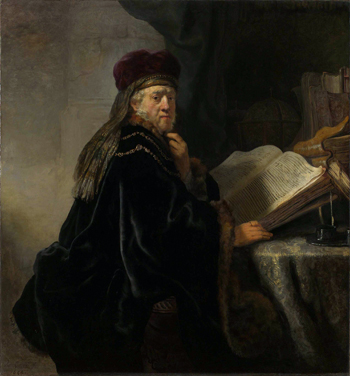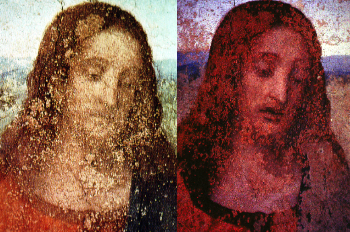Conservation Funding and Corporate Interest – A Look at the Bank of America Art Conservation Project
Ruth Osborne

Bank of America: The Art Conservation Project.
The price tag on conservation for a major work of art is rather steep. The funding of such a project allows a global corporation such as the Bank of America to exhibit its benevolent side to the public. Bank of America’s website for its Merrill Lynch Global Art Conservation Project boasts that it has provided grant funding for “museums in 25 countries for 57 conservation projects” since it began in 2010.[i]
One must also consider that they were one of several U.S. banks to receive billions of dollars from federal bailout in 2008-9, and suffered accusations of fraud and downsizing the very same year the Conservation Project began. The act of doling out millions of dollars to arts non-profits around the world is not without ulterior motive, and support offered to collections on six continents will not go unnoticed by public opinion. This year, Bank of America sets out to fund conservation on many masterpieces in collections around the world, including the following:
Museum of Modern Art, New York City: Jackson Pollock, Number 1A, 1948 (1948); One: Number 31, 1950 (1950); Echo: Number 25, 1951 (1951) * Read the Dec. 2012 ArtWatch article on MoMA’s Pollock restoration by Einav Zamir
New Bedford Free Public Library, Massachusetts: Alfred Bierstadt, Sunset Light (1861), Salt Lick in Sunset Glow (c. 1886), Mount Sir Donald (1889)
National Gallery of Ireland, Dublin: Daniel Maclise, The Marriage of Strongbow and Aoife (1854)
National Portrait Gallery, London: Pheonix and Armada portraits of Queen Elizabeth I (c. 1575 and c. 1588); Portraits of Edward VI and Edward VI and the Pope (c. 1542 and c. 1570)
National Gallery, Prague: Rembrandt van Rijn, Scholar in His Study, 1635
Kunsthistorisches Museum, Vienna: Titian, Ecce Homo, 1543
Musée d’Orsay, Paris: Gustave Courbet, L’Atelier du peintre (1854-55)
This project places Bank of America’s funding behind the promotion of culturally and aesthetically revered works of art on six continents. It has promoted, in the case of conservation at the National Gallery of Ireland, a series of study videos examining the themes and artistry behind the paintings. In this video, the Arts and Culture Manager for Bank of America in Ireland explains the financial corporation’s generous desire to improve and “redeem” artistic heritage “for the enjoyment of future generations.”
Their selection process takes into account works of significant cultural importance; a way to ensure their name remains at the forefront of art research and publication. Conservation treatment on the portraits of Queen Elizabeth I in London, for instance, is “fittingly coincident with the celebrations of the Coronation of Queen Elizabeth II 60 years ago.”[ii] Condition reports on restoration needs include canvas stabilization, yellowed synthetic varnish, pigment fading, flaked paint, and surface abrasion.[iii] A section on the Bank of America’s project website is devoted to showing the public works of art in the process of restoration: http://museums.bankofamerica.com/arts/Conservation/Detail.
Detailed images and ultraviolet photographs reveal the work of the conservators and curators as it is being done, allowing the curious public a privileged behind-the-scenes view.[iv] These also control the way audiences perceive restoration efforts and encourage them to understand the necessity of treatment. Rather than bringing conservators to greater accountability for alterations made to a painting, their work serves to captivate the public and convince them of the importance of the profession.
Another set of research images and conservation videos available on the National Gallery of Ireland’s website shows conservation specialists meeting the challenges of restoration: http://www.nationalgallery.ie/Home/Conservation/Strongbow_and_Aoife. Taken together, these glimpses make the public aware of all possible changes undergone by the painting over the course of restoration; convenient in case anything is done to significantly alter the painting from its former state.

Rembrandt, The Scholar in His Study, 1635. Courtesy: National Gallery, Prague.
According to the National Gallery of Prague’s press release concerning Rembrandt’s The Scholar in His Study, this will be both a restoration and research project set to unveil “anticipated new findings about the painting’s technical aspects.” These discoveries will then be suitable for publication in book format as well as on a new international Rembrandt Database: http://www.rembrandtdatabase.org/Rembrandt/.
The project anticipates and promises breakthroughs that will allow the public to learn about a Rembrandt they had never before known. Furthermore, interested audiences will also be able to watch and track the restoration on a website called “Tracing Rembrandt.” By making these discoveries public, the National Gallery of Prague looks to conservation so that its collection might gain renown and international exposure. Vít Vinas, acting General Director of the National Gallery in Prague, hopes this work will stabilize their Rembrandt so that it may now travel in exhibition.[v]
One must understand the different motivations for a painting to undergo conservation. Such treatment forever alters the visual and chemical nature of a work of art, and therefore should not be taken lightly. When a global corporation funds major conservation projects around the world, collections can be poked and prodded at the bequest of eager directors. Though the powers that be will insist conservation treatments are essential to the wellbeing of their collection, what results is not always the case. For such unfortunate evidence, see ArtWatch UK articles on the cleaning of Renoir’s Luncheon of the Boating Party in 1954 (http://artwatchuk.wordpress.com/2011/01/08/8th-january-2011/), and the repainting of Eakins’ The Gross Clinic in 2010 (http://artwatchuk.wordpress.com/tag/thomas-eakins-the-gross-clinic/). We at ArtWatch will certainly be awaiting the results of the upcoming Bank of America-funded conservation treatments.
[i] Bank of America Arts & Culture – Art Conservation. http://museums.bankofamerica.com/arts/Conservation (last visited 22 August 2013).
[ii] Arts News – Herald Scotland. June 6, 2013. http://www.heraldscotland.com/arts-ents/visual/arts-news.1370484298 (last visited 22 August 2013).
[iii] National Portrait Gallery – The Pheonix and the Pelican: two portraits of Elizabeth I, c. 1575 http://www.npg.org.uk/research/programmes/making-art-in-tudor-britain/the-phoenix-and-the-pelican-two-portraits-of-elizabeth-i-c.1575.php (last visited 4 September 2013); Steve Urbon, “New Bedford’s priceless paintings get gift of restoration. South Coast Today. SouthCoastToday.com. 18 June 2013. http://www.southcoasttoday.com/apps/pbcs.dll/article?AID=/20130718/NEWS/307180356 (last visited 22 August 2013); “New Bedford Free Public Library. New Bedford, Massachusetts.” Bank of America Arts & Culture – Art Conservation. http://museums.bankofamerica.com/arts/Conservation (last visited 4 September 2013).
[iv] Bank of America Arts & Culture – Conservation in Detail. http://museums.bankofamerica.com/arts/Conservation/Detail (last visited 22 August 2013).
[v] NG Prague – News – “Tracing Rembrandt: The Famous ‘Scholar in His Study’ Leaves the National Gallery in Prague.” Press release, June 18, 2013. http://www.ngprague.cz/en/128/3667/clanek/tracing-rembrandt-the-famous-scholar-in-his-study-leaves-the-national-gallery-in-prague/ (last visited 4 September 2013).



















 The Institute, in collaboration with various research bodies (CNR laboratories, Fisbat in Bologna, CNR Institute of Chemistry and Technology of Radio-elements in Padua, CNR Centre for the study of art works in Rome, the Institute of General Chemistry at Venice University) therefore carried out a number of surveys between 1977 and 1979, aimed at discovering the causes and the mechanism behind the deterioration, in the light of research into the overall conservation history.
The Institute, in collaboration with various research bodies (CNR laboratories, Fisbat in Bologna, CNR Institute of Chemistry and Technology of Radio-elements in Padua, CNR Centre for the study of art works in Rome, the Institute of General Chemistry at Venice University) therefore carried out a number of surveys between 1977 and 1979, aimed at discovering the causes and the mechanism behind the deterioration, in the light of research into the overall conservation history.


 When the Superintendent of Art in Florence assigned her to treat Michelangelo’s David, an awesome project on every level, those who might have wished that the Gigante be left alone were satisfied that there would be no danger to the integrity of the statue posed by Agnese Parronchi. It would be the crowning jewel of her life’s work, which would give her the kind of world recognition she had earned. When the Florentine officials wanted to impose upon her a very vigorous treatment which included the use of solvents, she did the impossible. She resigned, refusing to carrying out a cleaning which she considered too severe.
When the Superintendent of Art in Florence assigned her to treat Michelangelo’s David, an awesome project on every level, those who might have wished that the Gigante be left alone were satisfied that there would be no danger to the integrity of the statue posed by Agnese Parronchi. It would be the crowning jewel of her life’s work, which would give her the kind of world recognition she had earned. When the Florentine officials wanted to impose upon her a very vigorous treatment which included the use of solvents, she did the impossible. She resigned, refusing to carrying out a cleaning which she considered too severe.
